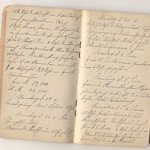 Slate, a naturally occurring material, was initially written on with a slate pencil. This was changed to a small stick of calcium sulfate or calcium carbonate, known as chalk. (Wikipedia) Since students frequently walked several miles to school, the economy of cost, size and portability of this writing tool matched the cultural need. The wooden frame surrounding the slate kept it from chipping or cracking.
Slate, a naturally occurring material, was initially written on with a slate pencil. This was changed to a small stick of calcium sulfate or calcium carbonate, known as chalk. (Wikipedia) Since students frequently walked several miles to school, the economy of cost, size and portability of this writing tool matched the cultural need. The wooden frame surrounding the slate kept it from chipping or cracking.
The slate was used to write assignments and complete tasks. Teachers would move around the room observing or correcting, before the work was erased for the next problem or dictation. Teachers frequently wrote the problem on each individual slate until students became familiar with the material and gained independence. Since students did not retain any of their work, memorization and repetition were emphasized.
Classrooms changed dramatically when James Pillan, who is credited with this invention, created the first wall-mounted chalkboard. This allowed the teacher to write material once. Students then replicated the work on their individual slates.
With the introduction of looseleaf paper (1913), lead and graphite pencil (1795/1861), pencil sharpeners (1895), erasers (1770/1839), and pen and ink (1897/1920), teaching and learning changed to suit this technology. The narrow design of the pencil made it easier for children to improve the quality of their written work. (School: the story of American public education) The notebook became a collection of pages, bound by string or coil (spiral bound, 1934) and allowed for the accumulation of learning into a more permanent record. As a result, teaching and learning changed focus.
Teaching and Learning with Slate and Notebook
To read more about the history of pen and paper, link to this research paper.
